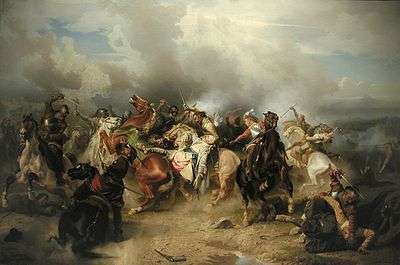Melee


Melee (/ˈmeɪleɪ/ or /ˈmɛleɪ/, French: mêlée [mɛle]) or pell-mell battle generally refers to disorganized close combat in battles fought at abnormally close range with little central control once it starts.[1]
In the 1579 translation of Plutarch's Lives of the noble Grecians and Romanes, Sir Thomas North uses the term 'pelmel' to refer to a disorganized retreat.[2] The phrase was later used in its current spelling in Shakespeare's Richard III, 1594:
"March on, ioine brauelie, let vs to it pell mell, If not to heauen then hand in hand to hell."
The phrase comes from the French expression pêle-mêle, a rhyme based on the old French mesler, meaning to mix or mingle. [2][3]
The French term melee was first used in English in c. 1640 (also derived from the old French mesler,[4] but the Old French stem survives in medley and meddle).[1]
In military aviation, a melee has been described as "[a]n air battle in which several aircraft, both friend and foe, are confusingly intermingled".[5]
Lord Nelson described his tactics for the Battle of Trafalgar as inducing a "pell mell battle" focused on engagements between individual ships where the superior morale and skill of the Royal Navy would prevail.[6]
The destroyer night action of the second Naval Battle of Guadalcanal on 13 November 1942, was so utterly chaotic and the ships were so intermingled that an officer on USS Monssen later likened it to "a barroom brawl after the lights had been shot out".[7]
See also
| Look up melee or mêlée in Wiktionary, the free dictionary. |
Notes
- 1 2 OED 2015.
- 1 2 https://www.phrases.org.uk/meanings/pell-mell.html
- ↑ https://en.wiktionary.org/wiki/pell-mell
- ↑ https://en.wiktionary.org/wiki/melee#English
- ↑ Kumar, DeRemer & Marshall 2004, p. 462.
- ↑ Fremont-Barnes 2005, p. 38.
- ↑ Frank, Guadalcanal, p. 441.
References
- Fremont-Barnes, Gregory (2005), Trafalgar 1805: Nelson's Crowning Victory, Osprey Publishing, p. 38 38, ISBN 978-1-84176-892-2
- Kumar, Bharat; DeRemer, Dale; Marshall, Douglas (2004), An Illustrated Dictionary of Aviation, McGraw Hill Professional, p. 462, ISBN 978-0-07-178260-9
- "mêlée n.", Oxford English Dictionary (online ed.), Oxford University Press, March 2015